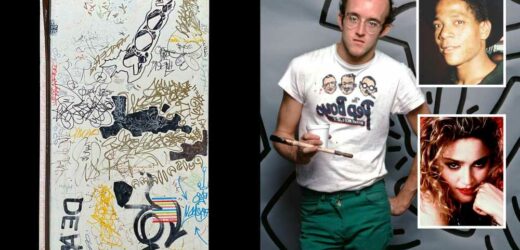More On:
keith haring
Why these Keith Haring, da Vinci art works are stirring up controversy in New York
Keith Haring mural cut from UWS wall could go for $5M at auction
Inside NYC’s most explosive public-art controversies
The epic rise and disgusting flameout of the artist who ruled 80s New York
This icebox is worth some cold, hard cash.
On Wednesday, Guernsey’s will auction off a refrigerator door that belonged to Keith Haring. The object — from the artist’s 1980s apartment at 325 Broome St. downtown — features more than 80 signatures and “tags,” including those believed to be by Madonna and Jean-Michel Basquiat.
Even more amazing, the artifact nearly perished before the current owner — who lived in Haring’s old unit in the early 1990s — grabbed it from a back alley before a garbage crew could take it away.
“It’s a one in a million kind of thing,” Guernsey’s president Arlan Ettinger told The Post. (Ettinger said that the piece is being sold “without minimum reserve,” meaning it will go for whatever the highest bid is.)
Haring often had raucous get-togethers at his Soho apartment, and his artistic guests left their marks on every surface of his home, from the brightly painted walls to the front door to his white icebox.
“We tagged everything,” artist Cy Adams told The Post, recalling the crowded, celeb-filled parties Haring would throw at his apartment. “When you’re a young graffiti artist, you don’t even think twice about it.”
Haring moved out of the Broome Street apartment shortly before he died of AIDS in 1990. That’s when the fridge’s current owner, an artist who now lives in San Francisco and wished to remain anonymous, moved in.
She answered found a listing looking for a roommate to share a railroad apartment in Soho for $250 a month. “I was immediately struck by the beautiful light in the front of the flat and the amazing bathroom … [and] the funky kitchen with the fridge covered in graffiti,” the woman told The Post.
When her soon-to-be roommate informed her that the apartment had once belonged to Haring, “I was stunned,” she said. After she moved in, she and her friends would examine it for names they recognizes. When the appliance stopped working, she ran out to retrieve the door after the man who delivered a new one threw it away.
“[It] was the centerpiece of the kitchen,” she explained. She ended up keeping it even after moving out in 1993.
Three decades later, she’s decided it’s time to part with the curiosity.
“I hope to pass this fridge on to someone, or some institution, who, like me, has a connection and appreciation for the power of everyday art. Someone who will get as much joy from looking at this as I have, and maybe share with a wider audience,” she said. “Graffiti is not meant to be static, nor is art ownership. … I have been a caring steward of this piece of NYC history for 30 years … it’s time to share this work with the wider world.”
Keith Haring
Haring put his own stamp on his graffiti-strewn fridge, of course. On the left side, he drew a big black blob splashed with some stars and arrows, while on the upper right-hand corner he stuck a sticker featuring his iconic “radiant baby” image, which he first began drawing in subway stations in 1980. Haring called that figure — of a crawling baby with lines emanating from its body — “the purest and most positive experience of human existence.”
Madonna
Madonna met Keith Haring when she was a struggling artist in the Lower East Side, and sometimes crashed on his couch when she couldn’t make her own rent. Later the Material Girl would wear the artist’s graffiti-inspired fashions on stage and in music videos, and the two stayed friends for life. It’s presumed she is the one who scrawled “Madonna Loves Keith” on the fridge. The singer was even with him the day he died of AIDS, in 1990. “He said what hurt him the most was how people did not want to touch door knobs after he touched them,” she said years later. “The discrimination then was next level.”
Fab 5 Freddy
Of course the flashiest, most florid tag here would belong to Fab 5 Freddy, the gregarious graffiti artist, film director, hip-hop pioneer and all-around Renaissance Man. Freddy (birth name: Fred Brathwaite) started out painting subway cars and was one of the first street artists, along with Haring, Basquiat and Futura, to infiltrate the fine-art world.
Futura 2000
Leonard Hilton McGurr — aka Futura 2000, aka Futura — also began as a subway scribbler, developing a highly stylized, almost abstract script that set him apart from other taggers. Later, his artworks frequently hung alongside pal Haring’s at the Fun Gallery in the East VIllage, and he later went on to collaborate with British punk band the Clash.
Jean-Michel Basquiat
Experts debate whether the “JM” at the bottom of the door actually belongs to Jean-Michel Basquiat, but the famed artist did spend a lot of time at Haring’s apartment. The two exhibited and partied together and inspired and pushed one another. In 1988, after Basquiat died tragically at 27 from a heroin overdose, Haring painted “A Pile of Crowns for Jean-Michel Basquiat,” featuring his friend’s signature crown motif.
Rock Steady Crew
The Rock Steady Crew popularized break-dancing in the early 1980s, thanks to troupe member Richard Colón — dubbed “Crazy Legs” for his acrobatic feats. The teenage “b-boy” from the Bronx soon became downtown fixture after his moves made him famous, getting into the groove at hot spots like Danceteria with Haring, Madonna and their crew. It’s assumed he was the one to scribble on the refrigerator.
LA 2 (Angel Ortiz)
Angel Ortiz began covering his Lower East Side neighborhood with his LA 2 and LA II tags when he was just 10 years old. (LA stands for “Little Angel.”) At age 13 he met Haring, and the two quickly began collaborating, with Ortiz filling in the spaces of Haring’s line drawings with his own dense squiggles. “We just immediately hit it off,” Haring said of their friendship. “It’s as if we’d known each other all our lives. He’s like my little brother.” When New York City in 2008 restored Haring’s mural on a handball court near Houston Street and The Bowery, Ortiz sneaked in and added his own flourishes. “When I was painting that mural, I didn’t feel like it was me,” Ortiz later said. “I felt like it was Keith’s spirit in me.”
Share this article:
Source: Read Full Article










